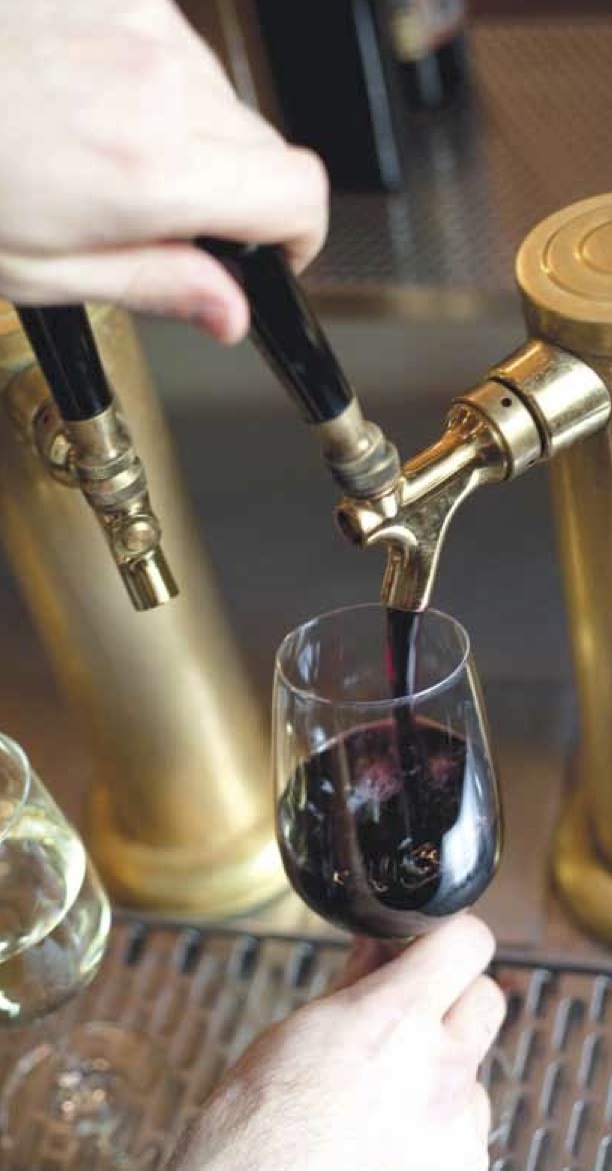
If you place a drink order at the bar at the Breslin by pointing to a tap, don’t assume you’re getting a beer.
The Breslin has four draft lines dedicated to wines on tap. That’s right—wine. They change seasonally, but in November there was a riesling and cabernet franc from New York State, and a syrah from California. Keg wine, fairly commonplace on the West Coast for some years, has become trendy very quickly in Manhattan. Red Hook Winery juice flows at SoHo’s Burger & Barrel, riesling fanatic Paul Grieco has his favorite white in keg at Terroir Tribeca and Michael White’s Osteria Morini has two Italian wines at spigot.
But in spring 2009, when wine director Carla Rzeszewski got a call from her boss, owner Ken Friedman, draft vino was still a fairly unblazed trail.
“Ken came to me and said, ‘Will you look into getting tap wine?’ Ken gets excited about ideas and just sends us e-mails saying ‘Please get on to this!’ There weren’t many people doing it in New York. Nobody said, ‘Hey, we have wine on tap!’ proudly. It was more an inexpensive way to sell wine in tinier restaurants.”
Rzeszewski got on the blower and hit the web. Finding willing collaborators wasn’t hard. “We were already doing it when Carla decided to install the lines,” says Christopher Tracy, the vaunted winemaker at Long Island’s mold-breaking winery Channing Daughters. “In late 2009, winemaker Rich Olsen-Harbich, formerly of Raphael Winery, started putting some wine in kegs for a Long Island restaurant called Verace. I talked to (them) and decided to jump right in.”
Asked why he leapt at the seemingly déclassé notion of putting a black-tie beverage in a blue-collar keg, Tracy reeled off a laundry list of reasons. “Environmentally friendly! No more wasted bottles, corks, capsules or labels! No garbage! No recycling! Less space needed for storage! No wasted wine! Good to the last drop. No throwing out unused or old portions of wine. Why toss a quarter or third of a bottle again? No corked bottles! No opening bottles! No broken glass!” Whew.
At the Breslin, Rzeszewski put in a tank of Channing Daughters’ Rosso Fresco. The riesling and Cab Franc are from Gotham Project, a New York company dedicated to keg wine, while the syrah hails from Berkeley’s Donkey and Goat.
Rzeszewski admits the syrah goes against one of the major selling points of keg wine—its green appeal. “Shipping empty kegs back to Donkey and Goat kind of goes against that,” she says, “but the carbon footprint is still substantially lower than it would be if I were serving that wine in bottles.”
It sells well—the Breslin goes through a five-gallon tank of each variety a week—and Rzeszewski has now put a line in at April Bloomfield’s sister restaurant, John Dory, down the block. Drinkers appreciate the price—keg wines range from $9 to $12 a glass. But they also seem to like the class-leveling notion of a wine that’s sold like a beer.
“It takes the preciousness out of wine,” says Rzeszewski. “People are intimidated by wine and I don’t think there’s any reason for that to happen. Keg wine breaks that down even further.”
Photo credit: Scott Gordon Bleicher



